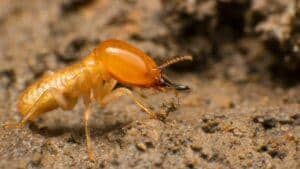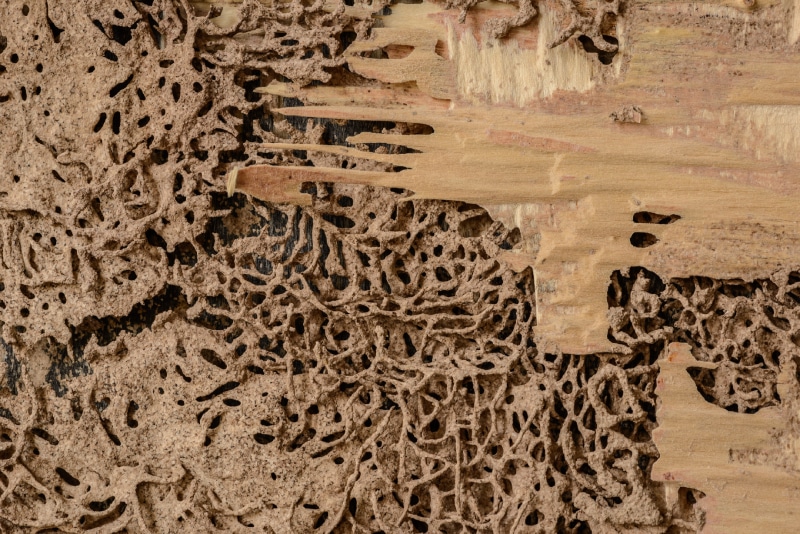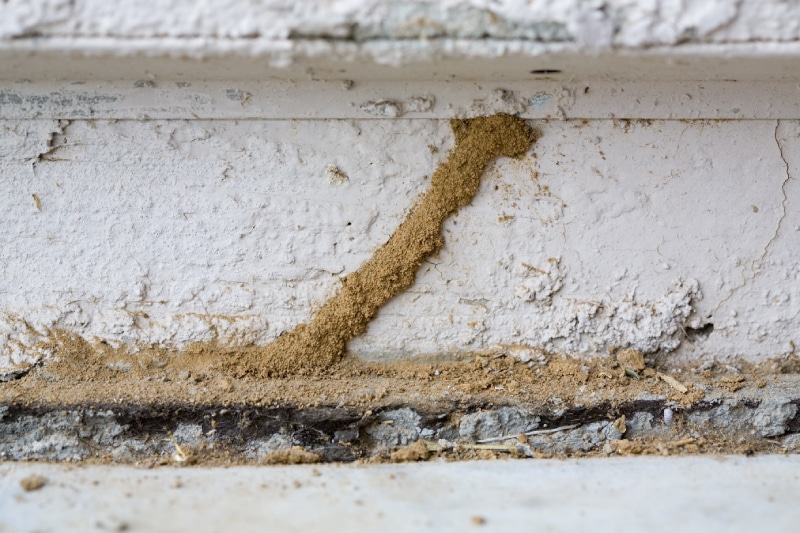
With their stealthy ability to create large nests before you find them, termites can create problems that cause costly repairs. Knowing how termites operate and how to accurately spot early warning signs could help save your time, effort, and hassle. Read through this comprehensive guide to discover how to find a termite nest.
What are termites?
Termites are invasive pests that are very covert and live in large colonies. They feed on wood but can also tunnel through insulation, pool liners, books, and paper. Termites are considered one of the most destructive household pests, with an average mature colony able to eat five grams of wood each day. Since termites can operate undetected for months or years, their slow and steady eating can cause structural damage in the hidden spaces of your home, causing unsafe conditions.
What do termite nests look like?
There are three types of termite nests most homeowners tend to come across.
Subterranean Termites
The most common type found in homes is the subterranean termite. Subterranean termites live and build their nests underground in mud and dirt. They create termite nests on your outside walls, constructed of tunnels or mud tubes, typically around the foundation, as hidden channels to your structural wood. These small termite nests typically look like cracks filled with mud on the lower foundation of homes.
Drywood Termites
Because they don’t require excess moisture to live, drywood termites can thrive in your walls, floors, attic, and even wood furniture. Drywood termites differ from subterranean termites in that drywood termite nests are often in structural beams, door and window frames, furniture, and hardwood floors, not underground. Their nests look like intricate, curving inlays within the wood. Because termites create these nests while they eat, they produce excrement called frass and kick it out of the nest. Doing this leaves behind piles of frass that appear similar to fine sand.
Dampwood Termites
The third type of termite is the dampwood termite, which looks for wood with excess moisture, typically in basements or unfinished attics. Like drywood termites, they create their nests inside the wood and can also leave behind pulp and frass.
Do termites nest in the ground?
Yes, subterranean termites are the species that nest underground, often near your foundation, and they create tunnels to your structure. If you see a moisture tube like the one pictured here, you probably have subterranean termites. These tubes offer shelter, lock in moisture, and protect the termites from dry air and predators. Finding small termite tubes on exterior walls may lead to greater termite tunnels in your yard.
How do you find a termite colony?
Finding a termite colony is all about knowing where to look. Termites aren’t interested in being located, so colonies will likely be in areas that don’t have high traffic. This typically means unfinished attic and crawl spaces, unfinished basements, and inside your walls, floors, and ceilings. There are various tools used to locate termites, with varying results.
- An acoustic emission detector listens for the sound of termites ripping wood fibers.
- Some use ice picks or screwdrivers to search for soft or hollow spots in the wood, although this may create damage where there wouldn’t otherwise be any
- Infrared imaging and moisture meters locate high-moisture levels.
- Borescopes have flexible shafts and fiber-optic lighting used to peer through small holes into hollow walls.
Of course, the best and fastest way to locate a termite colony in your home is to hire a professional pest specialist.
Signs of a termite infestation in your home
There are many signs to look out for if you’re concerned you have a termite problem. For subterranean termites, look for those pencil-thick mud tunnels on your foundation or crawl spaces. Indoor flying swarms of winged termites or piles of shed wings are other tell-tale signs of a termite’s nest in your home. Blistered wood could also be a sign of an infestation, thanks to the veneer on household wood that termites leave behind. Any bulges in floors, ceilings, or walls could signify that termites have caused structural damage to beams or support systems within your home. When you find any of these signs, it’s crucial to have your house checked as quickly as possible by a professional to get ahead of continued damage.
What attracts termites to your house?
All termites are attracted to wood, though each type has different preferences. As mentioned, drywood and dampwood termites seek dry or moist wood, respectively. If wood is overly brittle or saturated, it may increase the chances of termites moving in. Subterranean termites look for any wood directly touching the soil surrounding your home to build nests on concrete, brick walls, or foundations—deep structural and foundational wood you typically aren’t looking at on a day-to-day basis. Your geographic location and weather patterns can also increase the likelihood of a termite problem, with warm weather and consistent humidity making termites more active.
How do you get rid of termites?
Keeping a vigilant eye out for the signs of termites and termite colonies is a great way for homeowners to stay ahead of any potentially costly damage. Check for high moisture levels, reduce humidity in the home, and don’t let leaks or water damage go without the proper cleanup. Contacting local pest control experts like Hawx Pest Control is the most effective way to treat existing subterranean termite problems and help prevent their return or any further activity.
Termite pest control services
Make sure your home continues to be a place for rest, relaxation, and comfort. Hawx Pest Control provides residential services that help you manage pest problems without added hassle or stress. Our three-step process of inspection, infestation targeting, and barrier establishment is a thorough and lasting way to keep your home free of persistent pests. Preventing pests at their entry point eliminates their access to the places they inhabit most and keeps you enjoying your home for years to come.
Categories
RELATED POSTS





